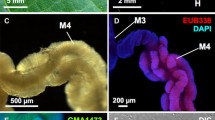Abstract
The genusSpiroplasma (helical wall-less prokaryotes) is a recently described group of microorganisms that cause disease in plants, arthropods, and experimentally, in vertebrates. Two spiroplasmas from beetles have now been discovered in a search for microorganisms suitable for biological control of economically important coleopterous insects. Colorado potato beetles (CPB) infected with spiroplasma were commonly found on potato and other solanaceous plants in Maryland. Although this spiroplasma occurred in high concentration in gut fluids and sputum, it could not be cultivated in conventional spiroplasma media. However, another spiroplasma (CN-5 and related strains) reported here to occur commonly in association with larvae and adults of the green June beetle,Cotinus nitida, could be cultivated readily in the SM-1 formulation and several other conventional spiroplasma media. The CN-5 spiroplasma was serologically distinct from representative members of all 8 major groups now recognized. Thus, it represents a ninth major spiroplasma serogroup (IX), and can be considered to be an unnamed species. The CPB spiroplasma is apparently maintained in plant surface-insect gut cycles, but details of maintenance of the CN-5 spiroplasma are incompletely understood. Isolation of CN-5 spiroplasma from soil in which host larvae had fed suggests that transmission of this agent may occur in the soil. Both CN-5 and CPB spiroplasmas exhibited unusually active translational motility in natural fluids, and CN-5 organisms exhibited such motility in culture media. Although we have no evidence that either spiroplasma is pathogenic to its usual host, the pathogenicity of spiroplasmas to many hosts, including the beetle,Melolontha melolontha, suggests possible application for biological control.
Similar content being viewed by others
References
Bové JM (1981) Mycoplasma infections of plants. Israel J Med Sci 17:572–585
Clark HF, Rorke LB (1979) Spiroplasmas of tick origin and their pathogenicity. In: Whitcomb RF, Tully JG (eds) The mycoplasmas, Vol. 3. Academic Press, New York, pp 155–174
Clark TB (1977)Spiroplasma sp., a new pathogen in honey bees. J Invertebr Pathol 29:112–113
Clark TB (1978) Honey bee spiroplasmosis, a new problem for beekeepers. Am Bee J 118: 18–19, 23
Clark TB (1982) Spiroplasmas: Diversity of arthropod reservoirs and host-parasite relationships. Science 217:57–59
Comstock JH (1949) An introduction to entomology, 9th ed. Comstock Publishing Company, Ithaca
Davis JJ, Luginbill P (1921) The green June beetle, or fig eater. NC Agr Exp Sta Bul 242; 35 pp
Davis RE (1978) Spiroplasma associated with flowers of the tulip tree (Liriodendron tulipifera L.). Can J Microbiol 24:954–959
Eden-Green SJ, Waters H (1981) Isolation and preliminary characterization of a spiroplasma from coconut palms in Jamaica. J Gen Microbiol 124:263–270
Giannotti J, Vago C, Louis C, Giannotti D (1978) Culturein vitro du mollicute agent de la “léthargie” des Coléoptères. CR Acad Sci (Paris) Ser D 287:379–381
Hurpin B, Vago C, Robert P, Meynadier G (1967) La léthargie, nouvelle virose des larves deMelolontha melolontha L. (Coléoptère, Scarabaeidae). Entomophaga 12:311–315
Jones AL, Whitcomb RF, Williamson DL, Coan ME (1977) Comparative growth and primary isolation of spiroplasmas in media based on insect tissue culture formulations. Phytopathology 47:738–746
Junca P, Saillard C, Tully J, Garcia-Jurado O, Degorce-Dumas J-R, Mouches C, Vignault J-C, Vogel R, McCoy R, Whitcomb R, Williamson D, Latrille J, Bové JM (1980) Caractérisation de spiroplasmes isolés d'insectes et de fleurs de France continentale, de Corse et du Maroc. Proposition pour une classification des spiroplasmes. CR Acad Sci (Paris) Ser D 290:1209–1212
Louis C, Plus N (1979)Drosophila melanogaster as an experimental host for study of multiplication and biology of the mycoplasma inducing the “lethargy of coleoptera.” Ann Microbiol (Inst Pasteur) 130B:415–431
McCoy RE, Davis MJ, Dowell RV (1981)In vivo cultivation of spiroplasmas in larvae of the greater wax moth. Phytopathology 71:408–411
McCoy RE, Williams DS, Thomas DL (1979) Isolation of mycoplasmas from flowers. In: Su HJ, McCoy RE (eds) Proceedings of the R.O.C.-United States cooperative science seminar on mycoplasma diseases of plants. National Science Council, Taipei, Taiwan, pp 75–80
Mooney J (1897–98) Myths of the Cherokee. 19th Annual Report Bur Amer Ethnology, p 308
Subcommittee on the Taxonomy ofMollicutes (1979) Proposal of minimal standards for descriptions of new species of the classMollicutes. Int J Syst Bacteriol 29:172–180
Tully JG, Rose DL, Yunker CE, Cory J, Whitcomb RF, Williamson DL (1981) Helical mycoplasmas (spiroplasmas) fromIxodes ticks. Science 212:1043–1045
Tully JG, Whitcomb RF, Clark HF, Williamson DL (1977) Pathogenic spiroplasmas: Cultivation and vertebrate pathogenicity of a new spiroplasma. Science 195:892–894
Tully JG, Whitcomb RF, Williamson DL, Clark HF (1976) Suckling mouse cataract agent is a helical wall-free prokaryote (spiroplasma) pathogenic for vertebrates. Nature 259:117–120
Vago D, Giannotti J, Meynadier G, Devauchelle G, Duthoit JL (1971) Recherches étiologiques sur la “léthargie” des Coléoptères. CR Acad Sci Paris Ser D 273:260–262
Vignault JC, Bové JM, Saillard C, Vogel R, Farro A, Venegas L, Stemmer W, Aoki S, McCoy R, Al-Beldawi AS, Larue M, Tuzcu O, Ozsan M, Nhami A, Abassi M, Bonfils J, Moutous G, Fos A, Poutiers F, Viennot-Bourgin G (1980) Mise en culture de spiroplasmes à partir de matériel végétal et d'insectes provenant de pays circumméditerranéens et du Proche-Orient. CR Acad Sci Paris Ser D 290:775–778
Whitcomb RF (1981) The biology of spiroplasmas. Annu Rev Entomol 26:397–425
Whitcomb RF, Tully JG, Bove JM, Clark TB (1982) Revised serological classification of spiroplasmas, new provisional groups and recommendations for serotyping of isolates. Curr Microbiol 7:291–296
Whitcomb RF, Williamson DL (1979) Pathogenicity of mycoplasmas for arthropods. Zentralbl Bakteriol Parasitenk Infektionskr Hyg Abt 1, Orig Reihe A 245:200–221
Williamson DL, Tully JG, Whitcomb RF (1979) Serological relationships of spiroplasmas as shown by combined deformation and metabolism inhibition tests. Int J Syst Bacteriol 29:345–351
Williamson DL, Whitcomb RF (1975) Plant mycoplasmas: A cultivable spiroplasma causes com stunt disease. Science 188:1018–1020
Williamson DL, Whitcomb RF, Tully JG (1978) The spiroplasma deformation test, a new serological method. Curr Microbiol 1:203–207
Author information
Authors and Affiliations
Rights and permissions
About this article
Cite this article
Clark, T.B., Whitcomb, R.F. & Tully, J.G. Spiroplasmas from coleopterous insects: New ecological dimensions. Microb Ecol 8, 401–409 (1982). https://doi.org/10.1007/BF02010678
Published:
Issue Date:
DOI: https://doi.org/10.1007/BF02010678




